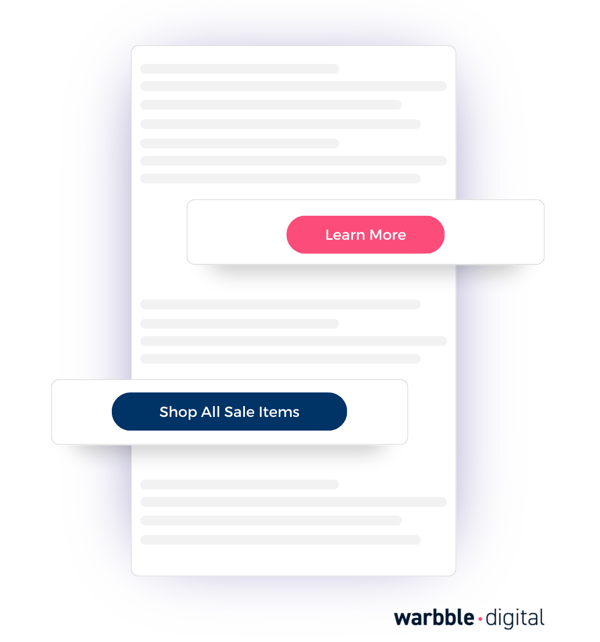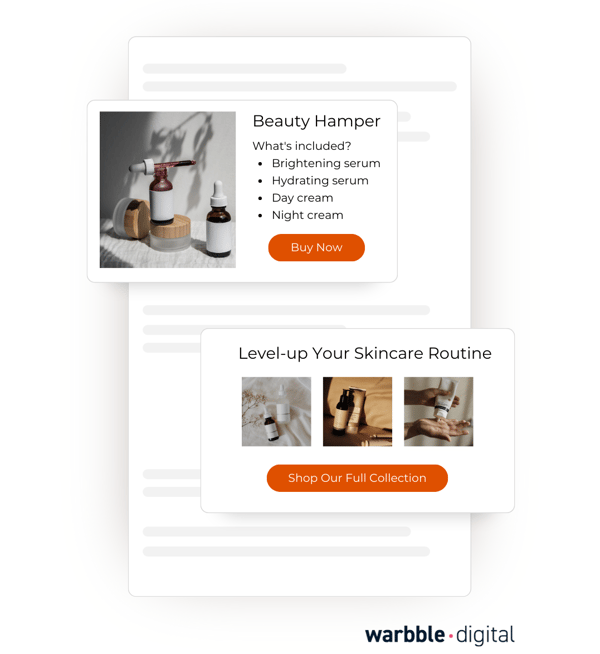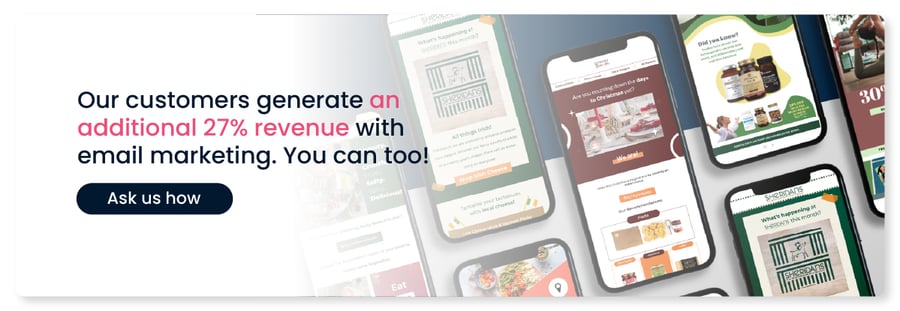Every time your business interacts with people, you are expecting excellent results. You want to see conversions, purchases being made, and goals being achieved. Every action a person takes should be impacting your bottom line positively, but is it?
Email campaigns are one part of your marketing strategy that should be providing you with exceptional results! We’ve found that our customers can easily generate an additional 27% revenue through email marketing. But these kinds of results don’t happen by chance — it takes work.
Some campaigns seem to hit the mark, generating high open rates and click-throughs, while others fall flat, leaving you wondering what went wrong.
The key to unlocking this mystery lies in understanding your customers' preferences and what they find appealing in an email. A/B testing can help you uncover these preferences in great detail.
What Are A/B Tests?
A/B testing, also known as split testing, allows you to compare two different versions of your email campaigns and measure which one performs better.
By creating variations of your emails and sending them to different segments of your audience, you can collect data and insights that reveal what resonates most with your customers. You can then use that information to craft future campaigns with the aim of getting consistently good performance.
Note: It’s best to conduct one A/B test at a time for accurate and actionable results. By isolating and testing a single variable, such as subject lines or CTA buttons, you can clearly attribute any changes in performance to that specific element.

Benefits of A/B Testing
Let’s take a look at some of the benefits of A/B testing.
Data-Driven Decision Making
A/B testing eliminates the guesswork and relies on concrete data to guide your marketing strategies. Instead of making assumptions about what your audience prefers, you can let the numbers speak for themselves.
Conducting A/B tests allows you to gather quantifiable metrics that reveal which variations of your emails perform better in terms of open rates, click-through rates, conversions, and ultimately, revenue generation. Armed with this knowledge, you can make informed decisions to refine and improve your campaigns.
Continuous Improvement
A/B testing also empowers you to iterate and fine-tune your email campaigns over time.
By testing different elements such as subject lines, content layout, visuals, calls to action, or even sending times, you can gradually optimise each aspect to maximise engagement and conversions.
Small changes based on A/B test results can lead to significant improvements in your email marketing performance and boost your return on investment (ROI).
Personalisation and Segmentation
Tailoring email content to different segments of your audience is another benefit of A/B testing. Sending different email variations to specific groups within your subscriber list gives you a chance to analyse how each segment responds to various elements.
Use this data to create personalised experiences that resonate with customer preferences and to ensure that your emails are more relevant and compelling.
Mitigating Risks and Reducing Costs
You never know what the results will be with an untested campaign. By evaluating different email variations on a smaller subset of your audience, you can identify and rectify any potential issues before rolling out the final version to your entire subscriber base. Doing so reduces the likelihood of wasting resources on underperforming campaigns and allows you to allocate your marketing budget more efficiently.
5 Tests to Increase Email Conversions
So where should you start? What should you A/B test first? There is no clear answer to this question, because there are so many different aspects to choose from. Start by deciding whether you want to A/B test a specific email campaign or whether one of your email flows is a better choice.
Regardless of which way you choose to go, here are some of our favourite tests to do, going from the simplest and building to more complex comparisons.
-
1. Email Subject Lines
Testing different subject lines is crucial because it directly impacts your open rates. Experimenting with variations can help you understand which subject lines resonate most with your audience and entice them to click open. For example, you can A/B test:

Personalisation vs. Curiosity
Compare subject lines that incorporate the recipient's name or other personalised information like "John, Check Out Our Exclusive Offer!" with subject lines that spark curiosity or pose a question such as "Guess What? Our Biggest Sale of the Year Just Went Live!"
Length and Tone
Test short and concise subject lines, for instance, "Limited Time Offer Inside!" against longer, descriptive subject lines that provide more context like "Discover the Latest Trends and Save Big with Our Exclusive Limited Time Offer".
-
2. Call to Action (CTA) Buttons
The colour and copy of your call-to-action (CTA) buttons have a significant impact on click-through rates since they need to catch the eye of the reader. A/B testing these elements helps you optimise the visual appeal and persuasive power of your CTAs.
Consider the following tests:
Colour Psychology
Compare different button colours (e.g., green, red, orange) to assess which elicits the strongest response from your audience. For instance, you could test a vibrant green button against a contrasting red button to determine if the colour impacts click-through rates. Another option is to use your brand colours and see how variations of them perform.
Copy Variation
Test different CTA copy options, such as "Shop Now," "Get Your Discount," or "Learn More."
Additionally, experiment with urgency-driven copy, like "Limited Time Offer - Act Fast!" versus more generic CTA text, to gauge the impact on conversions.

-
3. Position of CTA Buttons
The placement of your CTA buttons within an email can also influence conversion rates. A/B testing different positions helps you determine the optimal placement for maximum engagement.
Here are a couple of tests you can do.
Early Placement vs. Late Placement
Test placing the CTA button near the beginning of the email against placing it further down. This will help you understand if immediate visibility drives higher click-through rates or if building anticipation and providing more information first is more effective.
Multiple CTAs
Experiment with including multiple CTA buttons at different points within the email. For instance, you could have a CTA after introducing a product and another one at the end of the email directing readers to a category page. Using multiple CTAs allows you to analyse which CTAs generate more engagement and conversions.

-
4. Content
Testing different product approaches helps you understand which type of offer resonates best with your audience.
For example:
Prepacked Hamper vs. Gift Guide
Compare a single product promotion like a prepacked hamper (and explaining what’s in it) with a gift guide featuring several products.
Price vs. Value Proposition
Test emphasising the percentage discount — for instance, "50% Off Valentine’s Day Gifts!" — versus highlighting the value and benefits of the products — such as "Find the Perfect Gift that Dad Will Love at Unbeatable Prices!”

-
5. Types of Offers
Different types of offers can influence customer behaviour, so A/B tests can help you understand which offer motivates your audience to take action.
Some ideas for testing:
Higher Percentage Off vs. Smaller Percentage Off
Test a higher percentage discount like 30% off against a smaller percentage (say, 10%) with a sense of urgency, for example, "24-Hour Flash Sale: Save 10% Today Only!"
Limited Time vs. Limited Quantity
Experiment with time-limited offers ("Sale Ends Tonight!") versus quantity-limited offers ("Only 50 Units Left!"). This helps you gauge whether creating a sense of urgency through time or scarcity has a stronger impact on conversions.

Setting Up the Tests
Setting up A/B tests for emails requires careful planning and execution to ensure accurate results. Follow these steps to effectively set up your A/B tests:
1. Define Your Objective: Clearly outline the goal of your A/B test. Whether it's improving open rates, increasing click-through rates, or optimising conversions, having a specific objective helps focus your testing efforts.
2. Determine the Variable: Select the specific element you want to test, such as subject lines, CTA buttons, content layout, or product offers. Testing one variable at a time ensures clear insights into its impact on performance.
3. Create Variations: Develop two or more versions (A and B) that differ only in the selected variable. For example, if testing subject lines, create different subject lines while keeping the rest of the email content identical.
4. Split Your Audience: Divide your email list into equal segments and randomly assign each segment to receive either version A or B. This ensures a fair representation of your audience and minimises bias.
5. Establish Testing Parameters: Set a timeframe for your test and determine the size of your sample audience. Ensure the test runs long enough to capture sufficient data, considering factors like email delivery times and recipient behaviour.
6. Monitor and Track: Use email marketing software or analytics tools to track and measure the performance of each version. Monitor metrics like open rates, click-through rates, conversions, and other relevant key performance indicators.
A comprehensive email marketing platform like Klaviyo will make the entire process easy and guide you in setting up your A/B testing. Each platform has their own steps to do so, but they will be quite similar, and the basic steps listed above should work.
Interpreting Email Marketing Results
A/B tests are only effective if you check the results and interpret them so that you can adapt your email strategy accordingly.
The email platform you use will already provide you with several metrics, which means you don’t really need to do any calculations yourself. Email platforms should also have A/B testing features already in place, making it easier than ever to find out what works to increase email conversions.
The following are some of the metrics you want to check:
Open Rate
The open rate measures the percentage of recipients who open your email. A higher open rate indicates that the subject line and preheader text are compelling and resonate with your audience.
Compare the open rates of the A and B versions. If one variation has a significantly higher open rate, it suggests that the subject line or preheader text in that version is more engaging.
Click-Through Rate (CTR)
The CTR measures the percentage of recipients who clicked on a link within your email. A higher CTR indicates that the email content, including CTAs and visuals, engages your audience and motivates them to take action.
To evaluate which variation generates more clicks, compare the click-through rates (CTR) of the A and B versions. If a notable difference in CTR exists, it indicates that specific elements such as the CTA button, content layout, or visual design have an impact on customer engagement.
By analysing the CTRs, you can identify the version that effectively entices recipients to take action and refine your email campaigns accordingly.
Conversion Rate
The conversion rate measures the percentage of recipients who complete a desired action, such as making a purchase, filling out a form, or subscribing to a service. It indicates the effectiveness of your email in driving desired outcomes.
Compare the conversion rates of the A and B versions to determine which one is more effective, and use that knowledge for future campaigns.
Revenue Generated
Tracking the revenue generated from each variation provides a clear understanding of the financial impact of your email campaigns.
Analyse the revenue generated by the A and B versions to determine which variation contributes more to your bottom line. This metric is particularly important for e-commerce businesses or those with direct revenue-generating objectives.
Conclusion
The five A/B tests in this article are just a start; there are many other variations you can try to determine what works best for your customers. Even if you don’t get the results you are after, don’t give up. Continue with iterations until you strike gold. Once you do, don’t rest on your laurels — keep iterating and perfect your email marketing strategy.






